
Coming into Avengers: Endgame, it was clear the Russo brothers, and the brain trust behind Marvel, had chosen that movie as the end of the line for most of the “original” Avengers. Some would go into retirement, some would die a tragic, if ultimately fulfilling death. In the end, Tony Stark sacrificed himself to save the world, and Steve Rogers went back in time to be with the love of his life, Peggy Carter.
One sacrifice, one retirement, two Avengers out of the picture for good. Time for a new generation to step in. But the decision to sacrifice Tony, and let Steve live out his life in retirement was the wrong one. If anything, the other way around would not just have made for a more satisfying storyline, it would have prevented a lot of issues for the MCU going forward.
RELATED: Watch A Therapist Dive Into Tony Stark's Trauma Through The MCU
The idea behind killing Tony Stark, or allowing him to make the final sacrifice, is flawed to begin with. Tony Stark didn’t need to die to prove he was a hero. By the time Avengers: Endgame rolled around, Tony Stark had already proven that, over and over again. He didn’t even need to prove himself to the other Avengers – or he shouldn’t have had to. A hero’s journey doesn’t need to end in sacrifice to be satisfying, and Tony should have just been allowed to retire with Pepper and Morgan, with the tantalizing possibility of an RDJ cameo left open for the future.

Instead, Tony was forced by the storytelling to be the sacrificial lamb, because the writers had decided Steve Rogers needed to live. The problem, of course, is that it would have made much more sense for Steve Rogers to be the one to make the sacrifice. Not just because sacrifice is Steve’s move, but also because keeping him alive created a complicated mess that the MCU still hasn’t found a way to unravel. The fact that he went back in time, lived his life with Peggy, and still managed to come back to hand over the Captain America shield to Sam contradicts the very same time-travel rules Avengers: Endgame sets up.
Not to mention, it sets up an even thornier subject, considering Steve Rogers’s relationships within the MCU. After Peggy, Steve didn’t really date, but did flirt and share a kiss with one character – Sharon Carter. The problem is that Sharon Carter is Peggy Carter’s niece. And if Steve was always meant to go back and marry Peggy, that means he was also always Sharon’s uncle. Which is something Sharon should have probably known, and something that would have surely prevented her from kissing him?
The Falcon and The Winter Soldier, the show that should have addressed the issues with Steve’s decision to go back in time, goes out of its way to avoid mentioning Steve's fate. Fans don’t know if he’s alive, dead, or somewhere in an alternate dimension, as Avengers: Endgame indicated. Probably because, once the dust settled on Avengers: Endgame, common sense returned to Marvel. At this point, there’s no benefit to confirming what happened to Steve, and a lot of possible fans get upset with one confirmation or the other. But the problem had an easy solution: allow Steve the chance to make the sacrifice he always seemed ready to make. Allow Tony Stark the chance to retire in peace.

The movie could have, of course, chosen to sacrifice both, but even since Captain America: Civil War, the storyline was always leading to one of them living, the other one dying. Tony Stark had everything to live for. Steve Rogers didn’t. This is probably why Marvel chose to go for the twist, kill Tony, allow Steve to live, and go looking for that happy ending he didn’t get all those years ago. But nostalgia shouldn’t win over common sense.
Storytelling-wise, the MCU had moved far away from the possibility of Steve Rogers ending up with Peggy Carter by the time Avengers: Endgame rolled around. The canceled Agent Carter show had even set up a romantic alternative for Peggy, Daniel Sousa. After Avengers: Endgame, Marvel tried to fix that mess by bringing Sousa into Agents of S.H.I.E.L.D and having him end up with Daisy Johnson. But fans recognized damage control when they saw it. And many of them are still upset at the decisions Marvel made, particularly considering the ramifications these decisions have had on so many characters.
Tony Stark didn’t have to die to prove he was a hero. Steve Rogers shouldn’t have lived if the only way to keep him alive was going to screw up the Marvel timeline for years to come. Sometimes creators have to let go of the ideal ending and just write the best ending considering the circumstances. The MCU was always too interconnected for a singular decision not to affect many properties. And in this case, Avengers: Endgame's decision to sacrifice Tony Stark and let Steve Rogers live looks like the wrong one.
MORE: 'Black Widow' Star Scarlett Johansson Had Doubts About 'The Avengers'

